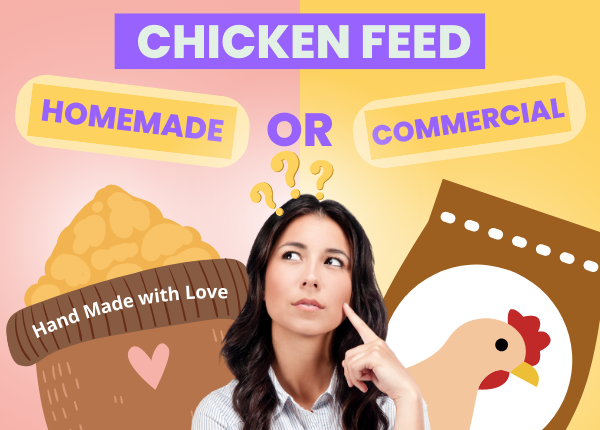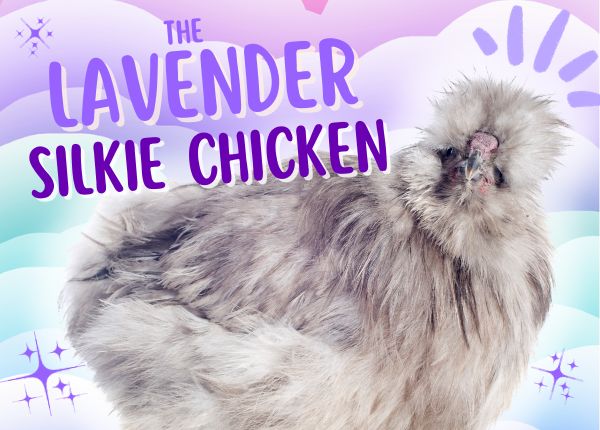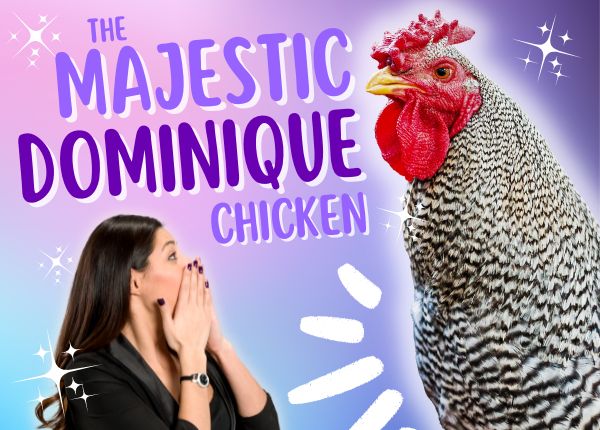
Firstly, there will be zero poultry parent shaming in this blog! What’s right for one chicken family, won’t be for another.
A fed chicken is a happy chicken. They honestly couldn’t give two clucks where their grub comes from, so long as you keep it coming!
Chickens are cheep to buy (pun absolutely intended) but feeding all those hungry mouths is not as easy on the purse strings. Making your own chicken feed can be more affordable than buying commercial feed, but often the saving isn’t that significant.
Saving money isn’t the only reason to consider making your chicken feed: DIY dishes have plenty of perks. To start with, there’s feeling as though you’ve utterly conquered homestead life as you dish out your homemade delicacies to your clucky ladies.
You’re also in complete control of what goes into your chickens, and into their eggs. You can even tailor your menu to suit your own needs, make use of seasonal foods, reduce household wastage, manage household allergies and factor in the fussy eaters in your flock.
On the flip side, there’s a lot to be said for the simplicity of store-bought chicken feed too. Sourcing the right ingredients, in the right quantities, at the right price to make your own feed can be tricky, tedious, and time-consuming. Mixing your feed can feel like a bit of a faff, and the anxious Annies amongst us must triple-check every measurement out of fear of getting the recipe wrong.
Whether you decide to hit the mixing bowl or the next-day delivery button - there’s a lot to know about chicken nutrition.
Regardless of whether you buy or make your chicken feed, it’s important to get this bit right! Find out all about your chicken’s nutritional needs, why, and how to make the right feed choices for your flock here.
Here are a just a few of your FAQ’s I am going to answer:
- How much does it cost
- How much time does it take
- Nutritional breakdown
- Is it safe to feed chickens Homemade Chicken Feed?
- Ultimate DIY Homemade Chicken Feed recipe
Is Homemade Chicken Feed Cheaper?
Homemade chicken feed can be a cheaper alternative to store-bought chicken feed, but not always, and not by a lot.
How much money you save by making your own feed will depend on three things:
1. The chickens in your flock:
How many, how large, their purpose, and their stage of life.
2. Access to ingredients:
If you have direct access to affordable suppliers or grow your own ingredients, you’ll keep the costs down.
3. Your dedication to research:
Understanding chicken nutrition, shopping around for cost-effective ingredients, and trialing different recipes will reduce waste and the need to supplement your feed at an additional cost.
Get your geek on! Take Chickenpedia’s Chicken Nutrition test here
The larger your flock - and the more feed they munch through in a month - the more economical bulk buying and batch-making your own chicken feed will become.

Homemade chicken fed doesn’t work out much cheaper than commercial feed for smaller, or mixed feed-stage flocks.
If you keep bantams, you might find it hard to buy ingredients in smaller quantities at an economical price, and if you make more feed than they’ll need, it will spoil and go to waste, because when you buy in bulk, you have to have the right storage options too!
The cost of ingredients can be managed by savvy shopping, growing your own ingredients, and balancing quantities of high and low-cost ingredients.
Quinoa, wild rice, amaranth seeds, and hemp seeds are all top-notch protein sources, but they come at top-notch prices. You can balance these with lower protein – and lower priced - grains like rye, barley, buckwheat, and sorghum.
Is Homemade Chicken Feed Safe?
Homemade chicken feed can be just as nutritious and healthy as store-bought feed. However, as the chef, it’s your responsibility to make sure that your menu meets the nutritional needs of every chicken guest in your diner.
Commercial feed offers reassurance that you’re getting the right nutrients into your barnyard buddies, whereas a mistake in DIY culinary calculations could be detrimental to your flock’s health.
Let’s not take this out of context though: there’s a big difference between detrimental and deathly. It’s understandable to worry that your DIY grub might not be on par with expertly tailored commercial feed.
But, there is a reason why there are so many brands and variants of commercial feed available…
There is no ‘perfect’ chicken feed recipe!
We want the very best for our beloved birdies (and for brilliant eggs), but don’t get too hung up on the precision science of the poultry palate.
Your homemade feed might not have as many diverse ingredients as a commercial feed, but it might contain fresher and even healthier ingredients! Unless there are any dangerous ingredients or major mishaps, your chickens will not notice a bit of a blooper.
Which Foods are dangerous for chickens?
Get familiar with this list of do-not-eats!
Is Homemade Chicken Feed Easy to Make?

DIY chicken feed can be as easy as mixing a handful of dried ingredients in large a metal drumb, or as demanding as a day’s diligent research and two hours in the kitchen cooking (yes, cooking) up snacks with half a dozen herbs🌿 and spices.
If your chickens are free ranging, you can keep your feed super simple, and your chickens will peck up their protein and mineral count with nature's delicacies.
If your chickens don’t have access to forage, then you’ll need to pack all their nutritional needs into one dish, so careful prep work and precision engineering will be called for.
How Long Does Homemade chicken feed last?
Homemade chicken feed should last for 3-6 months if stored in an airtight container in a cool dark and dry spot. Making more feed than you need will result in waste, so knowing your flock’s appetites will pay off when calculating your batch quantities.
Using whole grains rather than processed will help feed last for longer and retain more of the nutrients.
Can All Chickens Eat Homemade Chicken Feed?
Any breed of chicken can eat homemade chicken feed, but some breeds will appreciate it more than others. Certain chickens need such specific diets that it’s hardly worth all the faff.
Homemade chicken feed can be a great solution when catering to fussy fowl. However, the process of perfecting the little darling’s dish can require patience!
You can lead a chicken to feed, but you cannot make it eat. Chickens will eat what they want to and toss the rest aside like a toddler being served sprouts. They generally eat what they need, so you don’t have to worry about overfeeding them, but some cheeky ones will only eat the good stuff, and leave behind the grains they don’t like – Children, I tell you! 🙄
When your fussiest chicken tosses aside their commercial feed you probably won’t mind too much (she’s so sassy, that one), but when you’ve slaved over a weighing scale perfecting your protein to carb percentages, it can feel rather personal. Don’t be too hard on yourself, it’s them, not your cooking!
Hardy breeds like Easter Eggers, Rhode Island Reds and Orpingtons tend to be less picky about the contents of their plates, so will be more appreciative of your efforts.
If you are keeping broilers then they’ll eat a lot, but they need high protein feed and sourcing this can be more costly than buying ready-made grower feed.
DIY Chicken Feed for Layers
Before you set out your mixing station and invest in your ingredients, you’ll need to make sure you’re getting the percentages of protein and calcium right for each chicken in your feathered family.
Chicks, pullets, laying hens, and roosters all have different nutritional needs. Mixed flocks need eggs-tra careful planning.
Check out my ultimate chickenfeed guide to make sure your DIY dishes measure up!
What Nutrients Do Chickens Need?
All chicken feed should be made up of these five fundamental feed elements:
1. Proteins
Protein aids the development of muscle, skin, and feathers. The amount of protein each chicken needs depends on its developmental stage.
Popular animal-based protein ingredients are fish meal, meat, and bone meal. Plant-based protein options include soybean meal, corn gluten meal, and canola meal.
2. Fats
Fats, or fatty acids, produce calories and help your chickens absorb fat-soluble vitamins into their body, like vitamin A, vitamin D, vitamin E, and vitamin K. Extra fats also help your ladies chunk up and stay warm in cold climates or during winter months.
Popular ingredients include saturated fats like lard and tallow.
3. Carbohydrates
Carbohydrates are an energy source for your chickens, and they should make up most of your chicken feed.
Popular ingredients include corn, wheat, barley, and millet.
4. Minerals:
Microminerals and Macrominerals help with muscle and nerve function, and bone production. You don’t tend to get the right mix of minerals in grains, so mineral supplements are often added.
Popular microminerals include copper, iodine, zinc, and iron selenium. Macrominerals might include calcium, phosphorus, sodium, and potassium.
5. Vitamins:
Vitamins play an important role in your chicken’s growth and reproduction.
Some vitamins can be produced by chickens if they’re healthy and able, but others are supplied by natural food sources or supplements.

Homemade Chicken Feed Formula
This fab fowl-friendly formula from The University of Georigia can help you create your own, healthy recipes to suit your flock’s nutritional needs.
Working to a formula rather than a strict recipe means you can make the most of ingredients that are readily available in your kitchen, garden, or on sale at the store!
“The most common mistake in feeding poultry can be as simple as feeding the wrong feed…Growing broilers require as much as 23% protein, whereas laying hens and finishing broilers may only need 17–18%”(The University of Georgia).
Chickens love a varied diet just as much as the rest of us, so don’t get stuck in a rut with your ingredients.
Typical Nutrition Concentrations for Various Types of Poultry
|
Table 1. Typical Nutrition Concentrations for Various Types of Poultry |
|||||||
|
|
Protein (%) |
Methionine (%) |
Lysine (%) |
Calcium (%) |
Avail. Phos. (%) |
Fat (%) |
Fiber (%) |
|
Broiler (meat bird) |
|||||||
|
Starter (1–3 weeks) |
22 |
0.50 |
1.30 |
0.95 |
0.45 |
5.0 |
2.5 |
|
Grower (4–6 weeks) |
20 |
0.45 |
1.15 |
0.90 |
0.40 |
5.5 |
2.5 |
|
Finisher (7+ weeks) |
18 |
0.5 |
0.95 |
0.85 |
0.35 |
6.0 |
2.5 |
|
Pullet (young hen) |
|||||||
|
Starter (1–6 weeks) |
20 |
0.45 |
1.10 |
1.00 |
0.45 |
4.0 |
3.0 |
|
Grower (7–18 weeks) |
17 |
0.35 |
0.80 |
0.95 |
0.40 |
4.0 |
3.0 |
|
Egg Laying Hen |
|||||||
|
In production (19+ weeks) |
16–18 |
0.35–0.45 |
0.75–0.85 |
3.50–4.50 |
0.35–0.50 |
4.0 |
3.0–4.0 |
|
Note: Scratch feed should never be fed as a complete feed for any type of bird. |
|||||||
Source: University of Georgia
Chicken Feed Ingredients
Chicken feed ingredients are almost limitless, but here are some popular ingredients you ought to know your way around:
Oats
Oats are a protein rich and an affordable source of energy. They also contain B vitamins, calcium, and fiber. Oats and barley shouldn’t make up more than 15% of your chicken’s diet.
Wheat
Hard red wheat or soft white wheat are some of the most affordable wheaty pickings for nutritional value, but all kinds of wheat act as a strong energy source. Wheat is thought to improve digestion too, which helps prevent coccidiosis.
Kamut
Kamut is at the top of the crops for protein content, at 18%. It’s a popular brand of wheat grain and contains magnesium, zinc, and vitamin E.
Millet
Super-rich in amino acids and iron.
Corn🌽
Corn is low in protein, vitamins, and minerals, but it provides energy and fat. Corn is a large kernel, so you may need to crack or grind the corn first if your chickens are on the dainty scale, or you can feed them smaller popcorn kernels.
Sunflower Seeds
Sunflower seeds are nutrient-rich and affordable, and chickens love them! The oil is great for shiny feathers. They’re great in feed mixes, as treats, or you can be extra lazy and just let the sunflowers grow! They look beautiful, and it’ll keep the little blighters busy for hours trying to get to the treats at the top.
Black oil sunflower seeds
Black oil sunflower seeds (BOSS) are even higher in protein and mineral content than regular sunflower seeds.
Field peas
Field peas are easy to access and give your chickens an extra protein hit.
Lentils
Lentils are at least 26% protein: a great ingredient. But, just to warn you - not all chickens dig them.
Sesame seeds
One of the highest protein-content ingredients at 25 %, but also a dearer protein option than wheat.
Flax seeds
This is the way to get omega-3 fatty acids into your chicken’s eggs! They’re also rich in protein, B vitamins, and minerals.
Brewer’s yeast
Animal grade brewer’s yeast is an affordable route to B vitamins and around 35% protein.
Kelp Meal
Dried seaweed may sound gross, but it’s rammed with vitamins, minerals, amino acids, and salts. It’s great for darker egg yolks and your chicken’s health. We have a superfood here!
Oyster shells
A perfect calcium source for laying hens. This can be free fed if you have non-laying hens in your flock, as they won’t appreciate the extra calcium.
Crushed Eggshells
Another cracking calcium supplement. Egg-sess eggs can go back into your chickens (but not the way they came out) as a great nutrient source.
Salts & Mineral Salts
Free-range chickens will peck their way through salts on their own, but if your picky poultry is too posh to peck then you’ll need to add salts to their diets.
Homegrown Chicken Feed
Plant and grow your ingredients! Sorghum, amaranth, wheat, and kale are all easy to grow and your chickens will love you for it.

EASY DIY CHICKEN FEED RECIPE
Here’s an over easy and super-nutritious recipe to get you in the swing of this homemade chicken food thing.
Once you’ve made your first batch, you’ll feel confident to mix up your menus, and tweak your ratios to suit your fussiest cluckstomers.
• 20% corn (whole or cracked)
• 15% oats
• 15% millet
• 15% barley
• 10% peas
• 5% fish meal
• 5% kelp meal
• 5% sunflower seeds
• 5% dried blueberries or cranberries
• 3% eggshells or shell grit
• 1% vitamin-mineral premix
• 1% alfalfa meal

It’s not just chicken feed mix that can be homemade with love. Check out Chickenpedia for tonnes of homemade chicken snack recipes. They’ll be grateful. I promise!
So, What’s The Crack? Is Homemade Chicken Feed Worth the Effort?
It’s what we’re all wondering – let’s be honest!
Is it cheaper?
Whether or not making your chicken feed will benefit you financially depends on how accessible the ingredients are for you, whether you are growing any at home, and the size and variety of your flock.
Is it healthy enough?
This one is down to the chef. How healthy your chicken feed will be for your birdies, depends on how much effort you put into sourcing a range of ingredients and matching your menu to individual chicken needs.
Is it too much hard work?
How difficult your DIY chicken feed is to make will depend on your ingredients, menu choice, and how many birds you have with differing dietary requirements. It doesn’t have to be complicated.
Is it worth it?
If you have a large flock of laying hens homemade chicken feed will probably feel more worthwhile than if you’re tailoring dishes for pullets, laying hens, fussy bantams, or greedy Jersey giants.
More Questions about Chicken Cuisine?
Where your chicken feed comes from is just one piece of the puzzle…
- How Much Should I Feed My Chickens?
- What Is Free Feeding?
- What’s in Grower Feed?
- Which Foods Are Dangerous for Chickens?
- Which Chicken Grit is Best?
Find out all you need to know to get started with chicken nutrition in our ultimate chicken feed guide.
There’s so much to learn when it comes to caring for your little cluckers, and luckily, Chickenpedia has your back!
It’s the fastest, easiest, and most affordable way to get your geek on and learn all you need to know to be the ultimate chicken mama or papa. It’s also good fun! Get the kids and grandkids involved! You can even test yourself as you progress through their courses. Check it out here!
DIY Homemade Chicken Feed Recipe (free download)
- 20%corn whole or racked
- 15%oats
- Download the FULL recipe here











Leave a comment (all fields required)